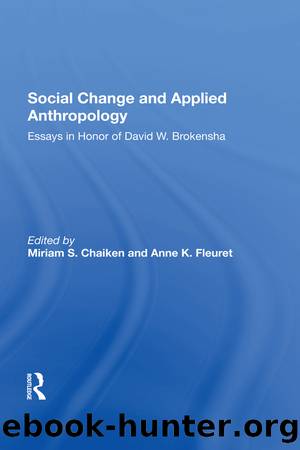Social Change And Applied Anthropology by Miriam Chaiken Anne K. Fleuret

Author:Miriam Chaiken, Anne K. Fleuret [Miriam Chaiken, Anne K. Fleuret]
Language: eng
Format: epub
ISBN: 9781000311679
Barnesnoble:
Publisher: Taylor & Francis
Published: 2019-07-11T00:00:00+00:00
* * *
Upper 5 14.3 6 16.7
Middle 5 14.3 21 58.3
Lower 25 71.4 9 25.0
Total 35 100.0 36 100.0
* Household counted as âTagbanuaâ if either spouse is Tagbanua
Second, the notion that the Tagbanua are poor because they are unwilling to work as hard as lowlanders is not supported by data collected on household time allocation. A year-long time use survey based on random observations of the daytime activities of adults in Napsaan5 found no significant difference between Tagbanua and lowlanders in the overall amount of time allocated to economic tasks over the year. As shown in Table 10.2, Tagbanua women engage in economic activities to the same extent as lowland women while Tagbanua men are only slightly less active than their lowland counterparts (see Conelly 1983 for details).
Though the amount of labor expended is roughly equal, the time allocation data do indicate important differences in the type of economic activities that the Tagbanua and lowlanders choose to pursue. For both ethnic groups, swidden rice production remains the dominant subsistence activity. But rapid population growth and a government ban on clearing swiddens from forest land above the village have resulted in fallow periods that now average only two or three years. As a result, the returns to swidden rice production in Napsaan are now precariously low, averaging only about 700 kilograms per hectare. This figure is less than one-half of the yield achieved in earlier years when fallow periods were typically ten years or more, and it is one of the lowest rice yields reported for a swidden system in all of Southeast Asia (Conelly 1983). In response to these declining returns, in recent years many Tagbanua men have intensified their collecting of rattan and copal in the forest for sale on the market. In contrast, lowlanders have increasingly focused their efforts on wage labor, irrigated rice production, tree crop production (e.g. cashew), and ocean fishing.6
Table 10.2 â Adult Daylight Time Allocation to Economic Activities by Ethnicity
TAGBANUA LOWLAND
TASK Females (nâ640) Males (nâ728) Females (nâ425) Males (nâ631)
Download
This site does not store any files on its server. We only index and link to content provided by other sites. Please contact the content providers to delete copyright contents if any and email us, we'll remove relevant links or contents immediately.
Cecilia; Or, Memoirs of an Heiress — Volume 1 by Fanny Burney(32093)
Cecilia; Or, Memoirs of an Heiress — Volume 3 by Fanny Burney(31481)
Cecilia; Or, Memoirs of an Heiress — Volume 2 by Fanny Burney(31435)
The Great Music City by Andrea Baker(30931)
We're Going to Need More Wine by Gabrielle Union(18664)
All the Missing Girls by Megan Miranda(14855)
Pimp by Iceberg Slim(13828)
Bombshells: Glamour Girls of a Lifetime by Sullivan Steve(13718)
Fifty Shades Freed by E L James(12936)
Talking to Strangers by Malcolm Gladwell(12916)
Norse Mythology by Gaiman Neil(12879)
For the Love of Europe by Rick Steves(11666)
Crazy Rich Asians by Kevin Kwan(8912)
Mindhunter: Inside the FBI's Elite Serial Crime Unit by John E. Douglas & Mark Olshaker(8751)
The Lost Art of Listening by Michael P. Nichols(7190)
Enlightenment Now: The Case for Reason, Science, Humanism, and Progress by Steven Pinker(6891)
The Four Agreements by Don Miguel Ruiz(6343)
Bad Blood by John Carreyrou(6295)
Weapons of Math Destruction by Cathy O'Neil(5872)
